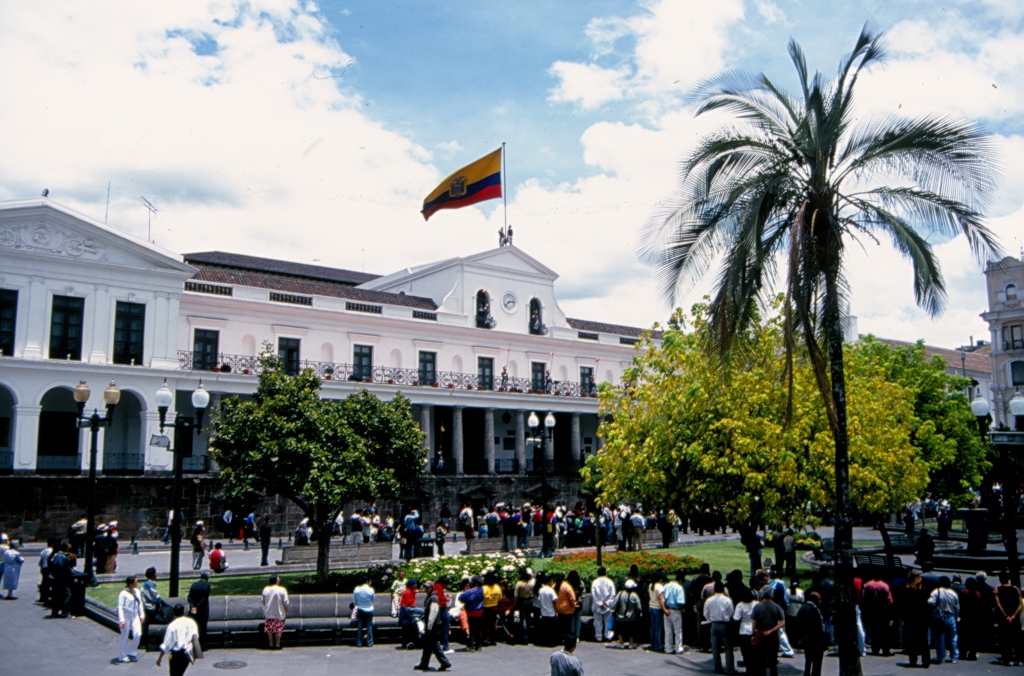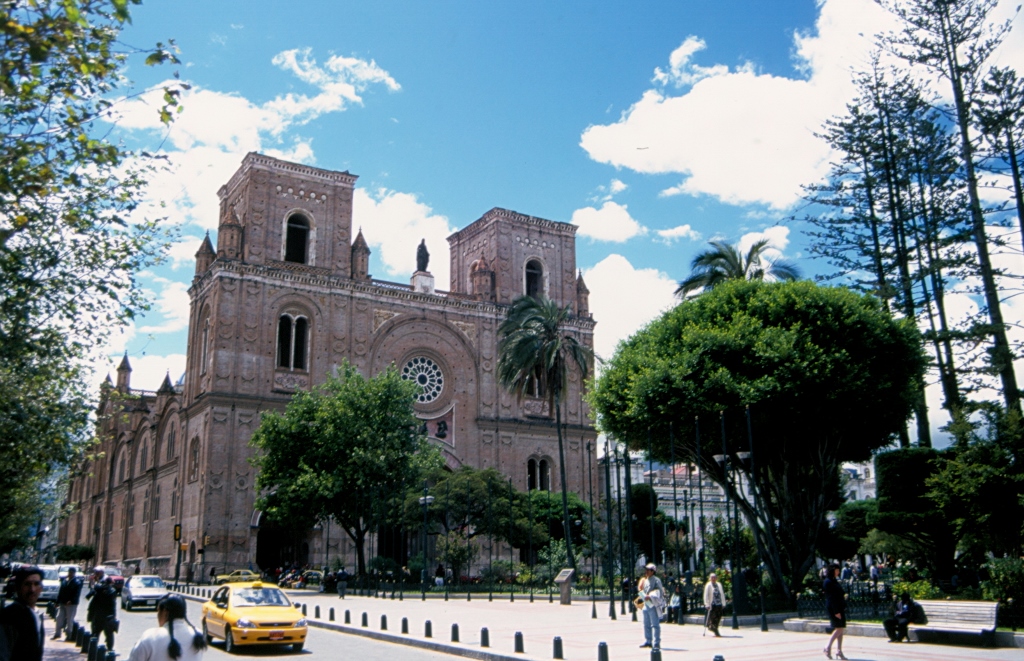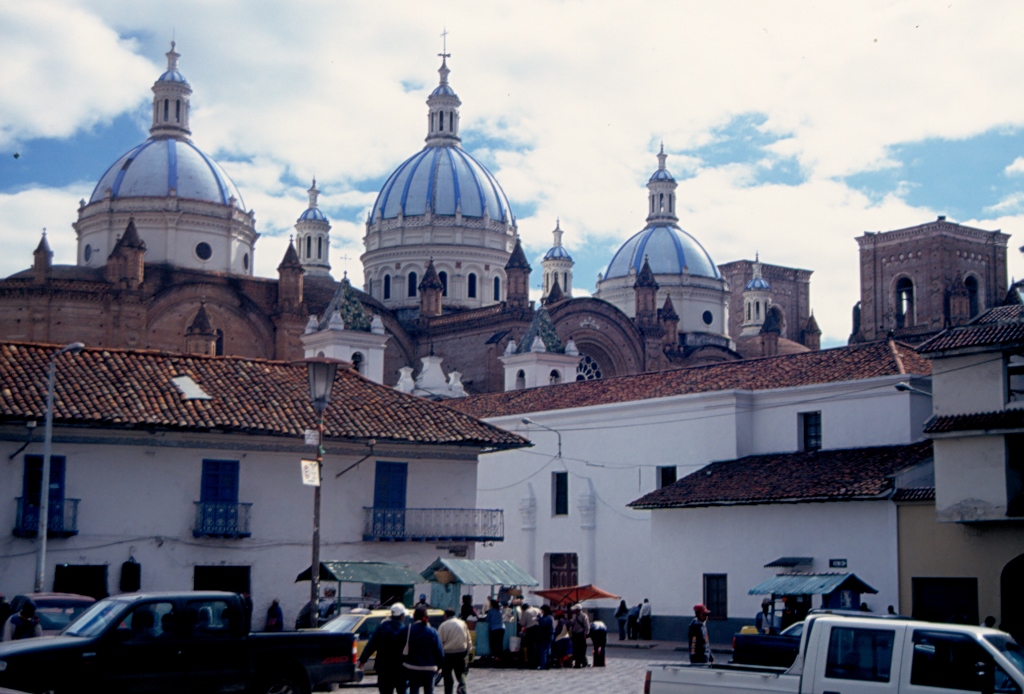It happened! As they say, there is a first time for everything and thus I felt the full impact of the effect known as “the first time when your baggage does not arrive on the same flight as you.” Of course, this first impression after having landed at the airport in Quito had nothing to do with Ecuador whatsoever, the “fault” was with the staff at the previous airport, but it was so strong that whenever I think about the beginning of my stay in this South American country I can never shake it off. I arrived in Quito, the capital of Ecuador, with an intention to stay in the country for around two and a half weeks during which I had already planned to go practically through all the seasons and there I was, standing in the airport building only with the clothes I was wearing and things that are most valuable for me and that go with me in my small backpack (a photo camera, a video camera, Tarot cards and my travel diary). Valuable things all right, but hardly at the level of practical. This was a truly dreadful situation and an extremely bad perspective for a stay in a country so far from my own. The shock that was on a verge of dumbness was very short-lived, replaced by desperation and a deep horror. All in all, the beginning was not a promising one.
After I had filled out the papers and was told to come the next day, I got into a taxi, came to the hotel, lamented about my sad destiny to the girl at the reception, who was not particularly keen on listening to that, and went to my room to sleep. Because of the tiredness caused by the lack of sleep during the journey and the extreme anxiety caused by the lack of baggage, I was simply unable to do anything else. When I woke up, the feeling of being tired had decreased, but the despair continued to be present. I got a city map from the reception and went for a walk and basic shopping. It was Sunday, so I was additionally worried where I would find bare necessities in an unknown place, but as it turned out, there was no need to worry, as there were numerous private shops open, so I got basic hygiene stuff and moved on. After the comfortable bed, this was the second encouraging thing in Quito – a toothbrush, toothpaste and a deodorant can be bought at any time of a day, even if it’s Sunday. This is just as a piece of information, in case one needs it. After the newly acquired sense of confidence caused by a fact that I would be able to brush my teeth decently, I headed to the other side, i.e., I went from the modern part of the city and the Mariscal Sucre quarter towards the old town. The day was nice and sunny, and there were many people enjoying the day with their children in the park that is cosily situated between the new and the old Quito. There were carts selling sweets and fruits – peeled mango and pineapple – everything was colourful and joyful, but I did find it extremely hard to concentrate and enjoy the life around me, for I simply could not get rid of the pressure caused by the lost baggage. With heavy heart I did manage to bring myself to the outskirts of the old town marked by Basilica del Voto Nacional, but then I gave up and returned to my hotel in a very bad mood.
In the morning I kept convincing myself that I should think positive, so with my head up high I went to the very centre of the old town in order to visit it a little bit before going to the airport. The old Quito is included in the UNESCO World Heritage List, but what is very important for an ordinary tourist, it was under heavy protection of police and so was the entire capital of Ecuador. I was told that until a few years before, it had been quite dangerous for one to walk into the old town even during a day, while now it was safe even at night. I couldn’t really imagine such tense situation, since Ecuadorians seemed like very nice and openhearted people, but I suppose that different circumstances in a country, including poverty as well, can play their tricks and bring the most unpleasant human traits up to the surface, to say the least. Ecuador is the poorest country in Latin America. Although they export a lot of petroleum, fish, shrimps, coffee, not to mention bananas, being the world’s largest banana exporter, this all is not enough for most of the population of Ecuador to live a decent life. One should only take into consideration the price of bananas in our countries and try to calculate how little money is paid to those who grow and harvest them once the profits of big corporations, transportation costs and all possible taxes are deducted. Because of the poor economic situation, every now and then the country also goes through some unrests instigated by hungry and poor inhabitants who, surprise, surprise, are of the indigenous origin. A few years ago, the US dollar was introduced as the official currency instead of the sucre, but this obviously did not help the economy grow, so unrests continue to take place from time to time. For me, as a foreigner, it was unusual indeed to see seriously armed policemen leisurely walking while leading official Rottweilers, but on the other hand, this is something that is decided by the country which I came to see of my own will, so I had no problem or an objection regarding that.
The old town of Quito, that is, the colonial part of the city is very picturesque. Other than beautiful, old-style buildings of different colours, old churches and nice squares, what first catches the eye is the charming wardrobe of its inhabitants. Of course, not of all of them, some are dressed more in some contemporary kind of casual style, but there are a lot of them, particularly women, who wear exceptionally beautiful and attractive traditional clothes. Later, travelling in some other Latin American countries, I will realize that each region has its own style, but what they all have in common is that they are picture-perfect and gorgeously beautiful.
I started with my walking tour from Plaza de San Francisco. There is also a church with the same name. It is the oldest church in South America and its construction started soon after the city was founded back in 16th century. Its interior was being renovated when I was in Quito, but regardless of the scaffolds, the service was held regularly.
After this square I sauntered left and right taking in the images around me. In addition to the nice buildings and the already mentioned beautiful traditional clothes, my attention was caught by quite a large overcrowding and noise mostly caused by too much traffic for such narrow streets. While in a cross-road I watched a conductor jumping out of a slowly moving bus and helping the driver by motioning to him how to make a safe turn into a cross street. Colonial Quito and its planners did not take into account large vehicles that came into being a few centuries later, so everything is just simply too narrow.
Walking on leisurely, I came to Plaza de Santo Domingo, again with a same-name church, but the church I really liked was La Compañia de Jesus which is generally considered to be one of the most beautiful churches in Ecuador.
Slowly I made my way to Plaza de la Independencia. This is a typical colonial square-shaped central plaza, also called Plaza Grande, with Liberty Monument, greenery, fountains, paths and a large number of benches. Around the square, there are numerous important buildings including also the Presidential Palace. First I sat on a bench for a while in order to collect my thoughts as to my whereabouts and how to proceed from there, but then I took advantage of the presence of an unsuspecting elderly lady who naively started to talk with me and I suffocated her with my lamentation about the lost baggage, since the issue continued to bug me and the entire walk around the old town was a kind of a coerced killing of time before the time was actually right to go to the airport and check whether my backpack had arrived. Just to make things clear, the poor woman survived the ordeal, while I actually managed to get rid of some negative energy and was ready to look around the square.
On the wall of the Cathedral facing Plaza Grande, there is a large stone sign with golden letters on it saying “The glory of Quito lies in the discovering of the Amazon river.” The Ecuadorians are very proud of the fact that one of the expeditions which left precisely from Quito while searching for El Dorado actually found the Amazon, but they have a lot of regret that a good portion of the formerly their territory containing the upper course of the river moved into the hands of Peru after the war between these two countries that practically took place on several occasions during the 20th century. The way I see it is that this whole thing about the “discovery” is simply too “Caucasian-centric”. I’m sure that the original inhabitants of the continent knew quite well about the river and didn’t need some foreigners to come there and claim the “discovery” as their own.
However, what I found most interesting at that point in time was that by sheer coincidence I came across the guard change which is formally done every Monday, and in my case without knowing of the thing I just happened to be in the right place at the right time. Regardless of the traffic that passed along the streets of the old town, including the narrow street separating the Presidential Palace and the square, the guard change took place slowly with a grand production, brass band, marching, and soldiers in historic uniforms. Some people like me stood there and watched the whole thing, while others simply went about their business not paying even the slightest attention to the performance which spread from the balcony of the Presidential Palace to the entire Independence Square. In order to better follow the choreography, I went up the Cathedral’s stairs and had a lovely view of the whole place.
 Presidential Palace, Quito
Presidential Palace, Quito
It needs to be said that Quito is situated at the altitude of 2850 m a.s.l., but taking into account that it is in the tropics, its climate is reminiscent of eternal spring. Weather seems to be difficult to forecast everywhere in the world, but in Quito this appears to be quite specific. Whenever I would ask people if they knew what the weather would be like that day or the day after, they would just laugh it off. Namely, none of the residents of Quito with whom I spoke believed that this was possible to predict in their city and simply said that one never knew. The weather can change completely within a quarter of an hour. I bore witness to that already on that first day when I walked around the old town. When I got to the Presidential Palace, it was completely overcast, with dark, low and dense clouds with heavy rain written all over them. As I was positioning myself on the stairs of the Cathedral in order to have a better view and as I was getting my cameras ready, the sky suddenly cleared up, the sun shone through and before the guard had changed there was not a smallest cloud in the sky. I had a completely opposite situation later when I went for a tour to Cotopaxi.
This “problem” with weather occurs because the air currents full of humidity from the ocean in the west and the warm, also humid air currents from the Amazon basin in the east climb uphill from the opposite sides of the Andes and then they bump into each other right above that middle valley. Generally speaking, continental Ecuador is divided into three parallel segments: the coastal region in the west, two parallel chains of the Andes that here mostly consist of volcanoes with fertile highland valleys between them, and the rainforest section in the east.
Once the guard change was over, I got into a taxi and went to the airport where, to my huge joy, I could take over my backpack that had arrived in the meantime. What a pleasure, happiness and a huge relief that was. With new vigour I went back to the newer part of the city where I started looking for a suitable Galapagos tour. Before going on the trip, I was lucky enough to interpret for some Americans working in tourism. I mentioned to them that I planned to go to Ecuador with the main goal being the Galapagos. They advised me not to book any tour in Europe or the USA, but rather to buy it in Quito or in Guayaquil, since it can be significantly less expensive. As a matter of fact, the entire trip started from talking about the Galapagos with my New York friend and how we would love to visit the place. Then we agreed to go all together, he, his girl-friend, her sister and I. In the meantime, I realized I had more free time than any of them and I decided to go before them and stay a little longer so that I could go around continental Ecuador. And this is what happened. During my stay in Ecuador, not counting the Galapagos archipelago which is located around 1000 km west of the continent, I concentrated on visiting the central, mountainous section.
The next day I flew to Cuenca, a city that is located in the south of the country and whose old town is also in the UNESCO World Heritage List. The airport is close to the centre which the airplane flew over as we descended, so one could enjoy a very pretty view. After landing, the airline gave us all a rose each and it seemed quite nice for them to do so. Later I realized that it was a symbolic gesture the aim of which was to emphasize that very pretty and good-quality roses are grown for export in southern Ecuador.
Cuenca is considered to be the most beautiful town in Ecuador and it is also one of the oldest in the country. My first impressions on the way from the airport to the hotel were not particularly great, but when I went for a walk around the centre I completely changed up my mind. My hotel was just a few minutes away from the main square in the Old Town called Parque Calderon. When I got there, I was left breathless with the beauty of the place. I continued to walk around and everything else I saw just kept expanding my delight with Cuenca. The streets in the old town are at a right angle, making orientation a piece of cake, and since the whole setting is not very big, I soon started to feel as if I had known everything around me. There is a large number of old churches and the streets are paved with stones, leaving no doubt that you are in a historic place. The buildings have lovely facades and although one may see occasionally that some of them lack maintenance that certainly does not take anything away from their beauty.
 New Cathedral, Cuenca
New Cathedral, Cuenca
The main square hosts the New Cathedral which started to be built in the second half of the 19th century, since the old one had become too small. What is particularly attractive about it are the three stunning domes covered in blue tiles that rise above the central nave. The two front towers were left shortened and without domes, since it was realized during the construction that there had been a miscalculation and that the foundations would not bear the weight of additional building material. As I entered the Cathedral, I was taken aback a little since I passed a woman leaving the Cathedral while leading a small dog on a leash. It seemed completely odd to me, for I find it hard to imagine that anyone would allow a dog in a church in my country.
 Domes of the New Cathedral, Cuenca
Domes of the New Cathedral, Cuenca
Not far from Calderon Park, there is Plaza de las Flores. There, on a small plateau in front of the church El Carmen de la Asuncion local women sell flowers which together with the mostly traditional clothes of those women created a very colourful picture.
Walking around Cuenca I particularly noticed women carrying small children using a wide shawl. Children are laid down on a shawl, one end of which goes under an arm while the other one goes over the other shoulder and then the shawl is tightly fastened in the front. This isn’t anything specific to Cuenca, later I would see the same thing in many other parts of Latin America, but it was here that I first became aware of it. And it is not used only for small babies. Even toddlers, of perhaps 3 or 4, are packed up like that. Some have their head showing, while others have even their head under the shawl. Still, although I would very much doubt my personal skills of packing and carrying a baby like that, it was completely clear that these were some very skilful moms and that the safety of their offspring was never compromised.